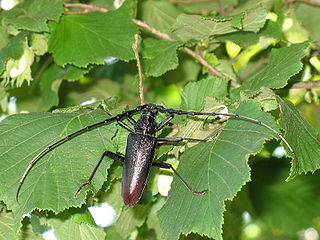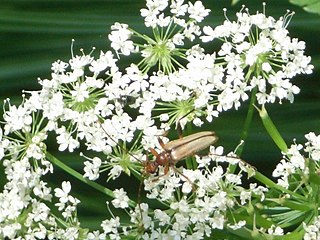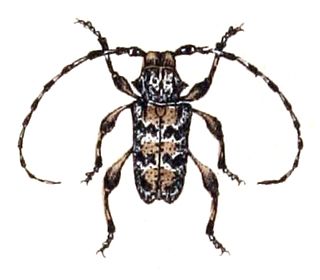
The French horn is a brass instrument made of tubing wrapped into a coil with a flared bell. The double horn in F/B♭ is the horn most often used by players in professional orchestras and bands. A musician who plays a French horn is known as a horn player or hornist.

The longhorn beetles are a cosmopolitan family of beetles, typically characterized by extremely long antennae, which are often as long as or longer than the beetle's body. In various members of the family, however, the antennae are quite short and such species can be difficult to distinguish from related beetle families such as the Chrysomelidae. The family is large, with over 26,000 species described, slightly more than half from the Eastern Hemisphere. Several are serious pests. The larvae, called roundheaded borers, bore into wood, where they can cause extensive damage to either living trees or untreated lumber. A number of species mimic ants, bees, and wasps, though a majority of species are cryptically colored. The rare titan beetle from northeastern South America is often considered the largest insect, with a maximum known body length of just over 16.7 cm (6.6 in). The scientific name of this beetle family goes back to a figure from Greek mythology: after an argument with nymphs, the shepherd Cerambus was transformed into a large beetle with horns.

A rhinoceros, commonly abbreviated to rhino, is one of any five extant species of odd-toed ungulates in the family Rhinocerotidae, as well as any of the numerous extinct species. Two of the extant species are native to Africa and three to Southern Asia. The term "rhinoceros" is often more broadly applied to now extinct relatives of the superfamily Rhinocerotoidea.

Cerambyx is a genus of beetles in the family Cerambycidae. They are commonly known as capricorn beetles, as their strong, stout and curved antennae, each segment of which flares towards the tip, are reminiscent of the horns of an Alpine Ibex or "capricorn".

The Disteniidae are a small family of beetles in the superfamily Chrysomeloidea, traditionally treated as a group within the Cerambycidae.

Acanthoderini is a tribe of longhorn beetles of the Lamiinae subfamily. It was described by Thomson in 1860.
Desmocerus is a genus of beetles in the family Cerambycidae, containing the following species:

Pidonia is a genus of beetles in the family Cerambycidae, containing the following species:
Aneflus is a genus of beetles in the family Cerambycidae, containing the following species:
Enaphalodes is a genus of beetles in the family Cerambycidae, containing the following species:
Stenosphenus is a genus of beetles in the family Cerambycidae, containing the following species:
Methia is a genus of beetles in the family Cerambycidae, containing the following species:
Styloxus is a genus of beetles in the family Cerambycidae, containing the following species:
Acyphoderes is a genus of beetles in the family Cerambycidae, containing the following species:

Trachyderini is a tribe of long-horned beetles in the family Cerambycidae. There are at least 140 genera and 650 described species in Trachyderini.

Aegomorphus is a genus of beetles in the family Cerambycidae, containing the following species:

Zographus oculator, the Orange-eyed Long-horn Beetle, is a species of flat-faced longhorn beetles belonging to the family Cerambycidae.
Poecilobrium is a monotypic beetle genus in the family Cerambycidae first described by Horn in 1883. Its single species, Poecilobrium chalybeum, was described by John Lawrence LeConte in 1873.










